
|  |

|  |
 e-mail: khokar1960@gmail.com Thanjavur Revisited Photographs: Raghavendra B.G February 21, 2022 Namakkal, Umayalpuram, Karur, Thiruvayyaru, Pudukottai, Oothukadu, Kumbakonam, Papanasam, Nagapattinam and Thanjavur (Tanjore, Thanjai)... dots on a map but very important ones, full of history and heritage. Not just of Tamil Nadu but India. The occasion is Thanjavur Utsavam, a brain-child of the PMO and Culture Ministry. OSD in-charge is Ratnesh Jha whose love for art follows the dictum charity must begin at home and it does with his wife Sushmita being a scion of the Amir Khan gharana of Jodhpur as taught by nonagenarian Dr. Shanno Khurana, she of the benchmark operas of the sixties and seventies fame Heer Ranjha and Sohni Mahiwal under Shiela Bhatia's baton. Dr.Khurana, her husband, was equally illustrious as chief physician to the first 3 Presidents of India and those days they had a car with the simple number D (for Delhi) LI 45. He was 45 years of age then so the registering authority asked him that and put that as easy recall number. Life was so simple in Delhi of the 60s we grew up in. Those days there were very few cars. Only the really well off possessed cars. In Delhi, not more than a 1000! Now every street has as many, with people fighting for space to park. Life was simple and Dr. Shanno Khurana has maintained simplicity despite high standards in art. Her best friend was the legendary Kathak dancer Damayanti Joshi of Bombay, who was the first one to see yours truly when I was born and only a few hours old on an odd date like Feb 29, in Baroda! She was my mother's friend too, so even before father could leave his university classes ("Why is he born in the middle of the day? At 1pm when I've class to attend to?" questioned my father like a true teacher, nay, founder head of the Baroda University MSU Dance Dept. As if I had any control over the time I was born!), Daman, as Shanno K called Damayanti Joshi, was the first one to visit mother and me in Maharani Shantidevi hospital, named after the mother of Maharaja Gaekwad of Baroda. Prime Minister's constituency as Chief Minister of Gujarat for 3 terms. First term PM too. Banaras was an add-on as Uttar Pradesh is critical to any national plan. 1/5th of Parliament seats are represented by U.P. Daman was the most dignified Kathak dancer of yore. Those who haven't seen her dance haven't seen good, dignified Kathak, period. She, then Roshan Kumari. Sitara Devi was the third active one those days, very popular but filmy too. Damayanti Joshi was class and substance. So much history there. No wonder I took to history as a subject, like duck to water and dance being in my DNA, I am most known today first and foremost as a dance historian. As a historian, it is left to us to write history, create history, rewrite it even and sometimes, make history!  So, returning to Thanjai after 40 years, I felt time had stood still. It had. For 1008 years. Exactly to date, since Raja Raja Chola died in 1014 ACE. We were all there to revisit history. The most active cultural institution of India today, the IGNCA was asked by its parent, the Culture ministry, to help organise the Thanjavur Utsavam under the ongoing year-long Azadi ka Amrit Mahotsav festival. AKAM can also mean Artist Ko Atyadhik Mila! Since past two years, artistes have not had much earnings, especially in times of the pandemic. I'm talking of professionals, not shaukiya society types, who dance and sing anyway. IGNCA is now the only pan-Indian cultural institution that can deliver under the direction of its visionary head Dr. Sachidanand Joshi. This man, being a litterateur, theatre artiste, academician and former VC of a journalism college in Raipur, has changed the face and fortune of IGNCA in the last 6 years of his term. From an organisation lying almost in coma, he revived it and gave it a fresh breath with many activities, even in Covid times, the last 2 years. He got the whole building shifted from Central Vista to a renovated Janpath hotel in the heart of Delhi. Again the same team of Achal Pandya was the main deliverer here too. 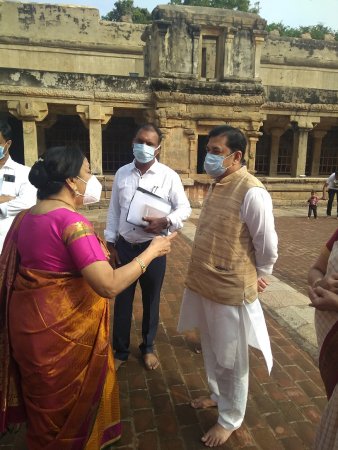 Padma Subrahmanyam in the temple complex IGNCA depended on its trustee from South India for content and Dr. Padma Subrahmanyam curated the whole festival. When she took charge of curating this 3 day Utsavam together, she set a new benchmark in HOW TO CURATE. Like all things in India, words are used without sense or meaning. Choreography has become even putting food on table now! Curating means how to arrange a table. We use words democratically. She showed what CONTENT is about: divided 3 days into Iyal (literature), Isai (music), and Natakam (dance) and structured morning and evening sessions with gems from all over: if there was a curtain raiser, literally Melaprapti by guru Herambanathan followed by Dr. Selvaraj with an excellent presentation on the history and heritage of Tanjore the first day, then the same evening Kavi Sammelan and Harikatha provided a glimpse to this aspect of literature, before Guru Kittapa Pillai's granddaughter Charumathi Chandrasekaran gave a reasonably good account of her lineage which was followed by a Kavi Sammelan where those whose word power matched their lung power could regale. Online lecture by Dr. G. Deivanayagam on architectural grandeur of the Big Temple was platformed. Prameela Gurumurthy's Harikatha lacked punch and never lifted from drawing room level or college level singing. She lacked the aura or stage presence to take audiences along. Giving her one hour plus cut into the time of others; especially the last artiste suffers generally. In any city in India, audience fatigue sets in by 8.30pm and by 9pm surely, most want to go home, eat and sleep. In metro India, the distances also make this adherence to time limit important. The main evening show on first day had to be compressed in a small hall due to rains, but Padma Subrahmanyam's team managed well as only professionals can when they presented pearls from Sangam period to Sadir. It was not a ballet or dance-drama as the title hinted but individual items strung together and excellently conducted by the icon herself. The trio comprising of Mahati Kannan, Srinidhi Vivekanandan and Ramya Venkataraman gelled well and the sparkling dance style of Vazhuvoor Ramaiah Pillai came through. He was helped professionally in Madras by Padma Subrahmanyam's father, the famous "director" Subrahmanyam, who helped many artistes get work in Madras those days. He was a philanthropist, philosopher, and producer too, always smiling and energetic. Guru Ramaiah Pillai directed many dance sequences in films of the 40s. Most studios set up dance shoot and we historians call it "diagonal dance" as it was devised for the camera to get maximum angles. Not front of stage to back like Tanjore Bala, who was strangely and maybe inadvertently forgotten in the 3 day Utsavam. A session on Tanjore Quartet would have been fitting as the margam format was devised by them, especially Varnam. Veena Dhanammal was a major force in music and her granddaughter Bala a world name. At least a session, a short film or talk on her would've enhanced the historicity of the Utsavam. Tanjore Bala put Bharatanatyam and Tanjore bani on the world dance map. Ram Gopal helped too as did Uday Shankar because Bala's guru Kandappa Pillai taught at Shankar's Almora school for 2 years in 1939 to 1941. Mahati Kannan, Ramya Venkataraman and Srinidhi Vivekanandan showcased the Vazhuvoor bani with its flourishes and flair. Sparkling gems all 3 and it was very difficult to decide if the music was divine, especially Dr. Gayatri Kannan's singing, or dance enhanced it. Gayatri is multi talented and so low key, as per maryada of South India. Never takes credit or stands out. So qualified and yet so simple. Dr. Padma Subrahmanyam conducted this special offering premiered here at Thanjavur Utsavam as a canvass of a century from Sangam to Sadir pearls from Tamil literature in dance form, since day one was on the written word, literature. She has Saraswati sitting on her tongue. So polite, so correct and each word is measured and clearly articulated. The hour plus long insipid Harikatha by Gurumurthy cut into the last artiste's time, the veteran Guru Kalyanasundaram, whose turn came at 9.30pm. Not fair to a 90 year old. He should have gone first in the evening slot and not left to suffer low audience in the end. But his one single student was equal to 100s seen over the 3 day festival. Her name: Shruti Natana Kumar. Wah! What grace, dignity, aplomb and unhurried delivery. It was as if the stone sculpture of the Brihadeeshwara temple had come alive. She was the hidden diamond of Thanjavur Utsavam. Others came with style or stardom, fame and awards to boot. She just came with her art. A tad nervous to perform in front of all such greats sitting in the hall, she was simple, unflustered and uncluttered in her supreme art. In the three days of seeing 300 artistes, she was the most graceful Bharatanatyam dancer one saw. Being a granddaughter of grand Guru Kalyanasundaram, is not easy. Imagine the expectations! Nattuvanars' sons normally do not dance, but Kalyanasundaram's son showed 4 Kautuvams in one go, bit hesitant and occasionally self conscious. Guru Kalyanasundaram Pillai is all of 90 on 1st of March (my hidden birthday too, since 29 Feb doesn't come every year, so the next best day is 1st of March), the oldest living, active and authentic nattuvanar of Tanjore, now in Bombay. Malavika Sarukkai, Vani Ganapathy and Lata Pada are his star disciples. Looking at his granddaughter dance was like going back in time when there was no need for anything extra to impress - speed, shine or stardom. She danced like a gentle breeze, economical and effortless in movement and an unhurried delivery. Languorous yet firm, dignified yet approachable. She is a future star of the form. Finally Bombay can boast of one new exceptional Bharatanatyam talent. 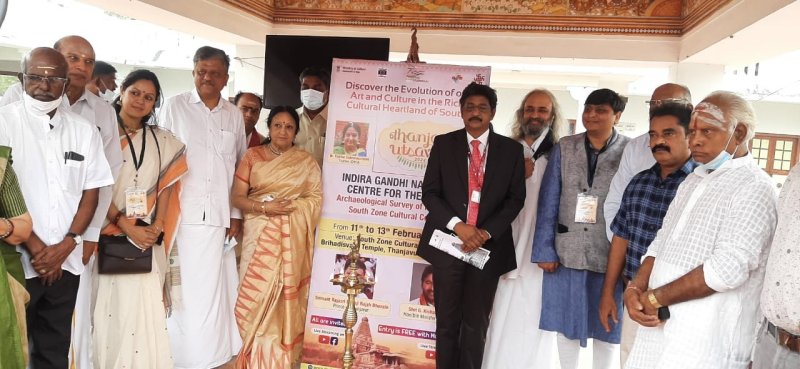 The moribund South Zone Cultural Center was the venue, revived by a fine exhibition on Brihadeeshwara compiled by Dr. P. Jha of IGNCA and from materials brought from Bangalore centre too. Pondicherry head of the IGNCA, all suited and booted, conducted some of the proceedings in Tamil. Sitting next to me was a shining star of TN (Tamilnadu) Narthaki Nataraj, now a nominated member of the TN legislative too. She said COME TO MADURAI to hear classical Tamil. TN is so rich in varieties of Tamil that even natives can't decide which is best. She kept calling me Mohan, and I felt so happy that 20 years after my father's death, his name was still invoked by gen next so affectionately. Narthaki must have been about 20 plus when father died 23 years ago. At the inaugural, the Prince of Tanjore, Raja Sahib Bhonsale was the epitome of grace and was humble enough to say, 'WHO AM I? A mere caretaker of the gift of the gods.' For those who need a ready reckoner of Tanjore history, its greatest ruler was Raja Raja Chola (985-1014CE) followed by his son Rajendra. They not only strengthened the Chola Kingdom, built temples like the Brihadeeswara (where in its gopuram passage the famed 81 karanas were first discovered by the ASI and this time Dr. Padma Subrahmanyam, who did her PhD on the subject, personally conducted and showed each and this was a highpoint of having arrived a day earlier just to study this marvel with her). She must have been a queen here in Chola times, when she walked in the Brihadeeshwara complex, and each stone talked to her and welcomed her. This is not this life alone - her work and scholarship - oeuvre and devotion. This is truly purva janamam sanskara and prahlabdh (many previous lives' accrued karma and fate). The next evening, unseasonal rains threw some of the open air events in disarray, including the big open air hall created with much effort, shamiana and all.  Excellent isai or music was the focus on day two - RRR; Rajashri Ramakrishnan, Rama Kausalya and Rable Rousers! Those were the three in the morning session that stood out. The first was a good depiction on musical heritage of Tanjore, the second a good concoction of Tanjore coffee culture as an art form (in addition to many other cultural traits) and third was a loud, rambling, naama sankeertanam which went bombastic. There was no bhakti, just branding of their ashram and tours abroad. One little boy on miniature mridangam provided delightful diversion but on the whole there was cacophony. Musicians need to understand softness and subtlety. Just increasing volume doesn't help in a small hall. No rasa in their rendition except one dark horse whose voice was the best. Others looked like 3 generations of uncles and nephews out on a holiday, singing their way for supper! This may work well in a family or temple gathering not on proscenium stage. They need to evolve class and substance. Folk forms again bunged in a small hall, obviously the organisers were clueless and had never seen these before. Core competency in performing arts seemed lacking in event planning. So a huge peacock or horses could hardly move in the hall and when there were so many open spaces of the SZCC, why not have done it in the open? Our folk and street forms are meant for performing in the open. Rains having abated on the second day, the large open air hall was used to get the star of Carnatic singing today, the squeaky-clean looking, dimpled, handsome boy wonder Sikkil Gurucharan. Son of one of the two famous Sikkil sisters of flute, he is poised perfection. First rate selections, punctual and pleasant evening. Next was violin by Lalgudi G.J.R Krishnan and Vijayalakshmi. Passable. To again have a vocalist after that (Soumya) was a case of diminishing returns; it was 9pm and all were fatigued. The concluding day started early with a film on compilation of karanas produced by IGNCA called Karana Ujivanam at the Murugan Mandapam, courtesy special permission of the ASI. Only a handful could be accommodated in this most special chamber within the precincts of the Brihadeeshwara Temple, because many small ones dot the area. The compilation is 11 hours almost and comprises of lifetime work on karanas by Padma Subrahmanyam, who has used these dance sculptures found in 3 temples - Brihadeeshwara, Kumbakonam and Chidambaram - to recreate her own dances. 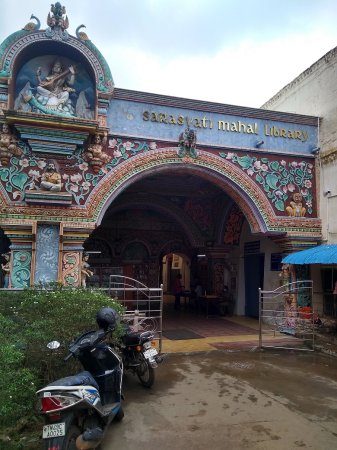 From the temple to the proscenium stage, the small hall of the SZCC became the venue for a few interesting lec-dems. Due to morning film release at another venue and visit to the most important landmark for us writers - the Saraswati Mahal Library within the palace complex - one missed two artistes slotted in the SZCC small hall and could hear the flowery speech of Sarala on dance techniques in classical literature (shouldn't this session have gone on first day events on Iyal / literature?) and a wholesome lec-dem on Melattur Bhagavata Mela by N. Srikanth. He needed more time to elaborate, so there was a sense of being jumpy but his discourse was well planned and articulated. A senior star dancer guru of Pune, Dr. Sucheta Bhide Chapekar being the first rate professional she is, conducted the most soothing and scholarly session and the audiences learnt much as to why the Maratha rule was a value addition and the Serfoji rule made Marathi part of court and culture; how Sucheta's guru, the great Parvati Kumar created a whole genre of Hindustani Bharatanatyam that was more easily accessible to all in that region. Sucheta has a quiet, understated elegance and attitude. Her girlish laugh belies her 70 plus age. Her simplicity is her best abhushanam. Her sustained work over 40 years, visiting Saraswati Mahal, the famed library for research made me bow down to this repository of knowledge. She is a lighthouse in Pune region for Bharatanatyam and her able daughter runs Kalavardhini well. Here also, Padma Subrahmanyam needs to be complimented for choosing and including the senior most Maratha dance talent on the occasion. Next, Priye Murle with students covered most of the stage. Why couldn't she have been slotted at 3pm when hers was a routine show and senior scholarly Sucheta Bhide not later? Madras artistes one sees often; Pune seniors doing Tanjore-linked items is a rare treat. Priya's students were sprightly and successful in holding audience attention. Well choreographed too. The concluding day's evening offerings were 3 excellent choices: Narthaki Nataraj, a popular star of TN today, whose stars are also on the rise thanks to her-time-has-come syndrome. And she showcased why her art is unique. Clear, crisp deliveries and tightly knit movements make her dance a delight. She was most sought after for selfies too! Mysore Manjunath and team on the violin showed what true professionals they are, even at that late hour when only a handful were left in the huge maidan of a hall. He with Pt. Praveen Sheolikar played first rate for full 75 minutes, with no compromise. Shamsi on the tabla confirmed my historians' penchant for discovery that he was from Kashmir, which none present had known. Pandit to boot, resettled in coastal Karnataka and Maharashtra. All of India seemed to have met at Thanjavur Utsavam. That was its beauty. 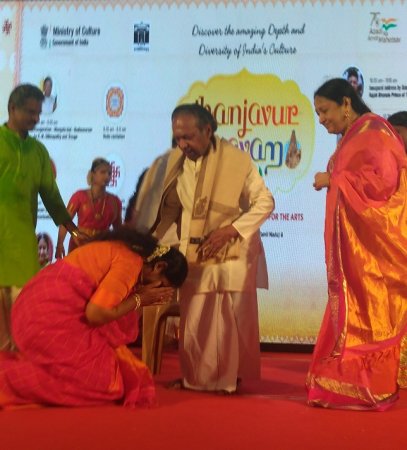 Guru Kalyanasundaram being honored The valedictory function honoured senior most Bharatanatyam guru of Bombay region, the one and only ebullient Guru Kalyanasundaram, entertaining and educative too. He wears his talent lightly. It's a typical Piscean quality. He is also a laugh a minute. His wife's happy face glows with joy when he is pedastalised and honored with all due pomp and show. There's a tear in many an eye as this doyen of dance accepts it with humility. He is the last great nattuvanar left. He deserves a Padma Bhushan. For us, he is a Bharat Ratna of dance anyway. What does one take home from this Utsavam? That the Culture Ministry chose well, first IGNCA itself as a nodal agency, then the concept. IGNCA can provide content and artistic deliveries. Second point is helping arts industry in the process. Performing artists never have it easy in times of the pandemic. Thus these unique initiatives (like AKAM) of the Culture Ministry help everyone involved. This model of Thanjavur Utsavam works. First was done in Kashi, then now South in Thanjavur. East and west next will be best! Last one in Ujjain, so pancha bhutam covered. This template of AKAM (Azadi Ka Amrit Mahotsav) also gives much needed fillip to arts, crafts, technicians, hotels, tourism and other services like transport, trains, buses. We need this re energizing after karona kaal. Lastly, this great effort of Thanjavur Utsavam and grand success needs to be sustained every year. It helps tourism. The state must take it forward no matter which government is at the centre. It is for people of India; don't let governance and POLITICS divide. Language already has. February for me was fulfilling going back 150 years in time to my mother's grandmother's house (now a mall) in nearby Kumbakonam. I wanted to touch that holy land and bow down to Lord Sarangapani, where the second set of famed karanas are, the third and last set being in Chidambaram. So, 10th century karanas (81) found in Tanjore (Brihadeeshwara temple); 11th century in Kumbakonam (Sarangapani temple) and third in Chidambaram (Nataraja temple) of 12th century. Told you, I was born to history, on a historical day and I'm writing history thus I'm truly and foremost a historian at heart. Thank you for the listen! 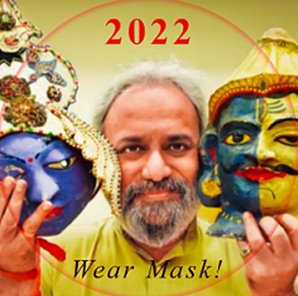 Khokar is a critic by profession, historian by education, administrator by experience, archivist by disposition and celebrator of art and artists by spirit. attendance-india.com Responses * Thanks for making me feel like a part of the festival through your article. I like your critic eye and appreciate the artist's work, the way you pay respect to the legends which made me glued to the article as if myself am part of it. - Preet Tiwana, Patiala (March 10, 2022) * This article encapsulated the whole festival so beautifully. Could visualise every bit and also envy the witnesses of this festival. Enriching and rewarding to read, learn and understand many aspects of art and history. (Feb 28, 2022) * This was an amazing article bringing in the different Art forms and so much of history. I always love the personal touch you bring to it. - Minal Prabhu (Feb 23, 2022) * This article is like history itself. Going through, it gives the feel of as if you have lived for so many eras. - Vandana from Mauritius (Feb 21, 2022) Post your comments Please provide your name and email id when you use the Anonymous/blog profile to post a comment. All appropriate comments posted with name and email id in the blog will also be featured in the site. |